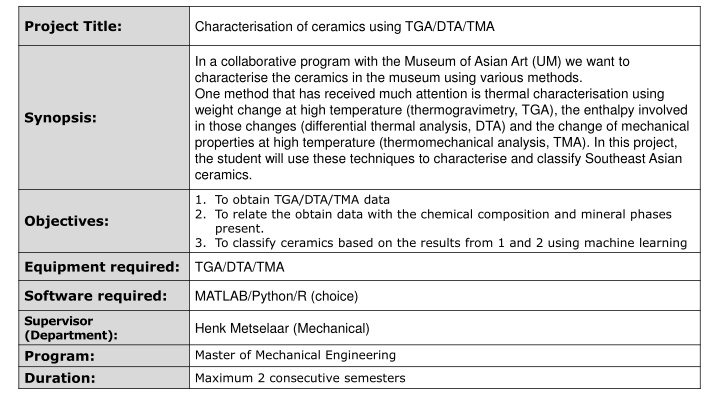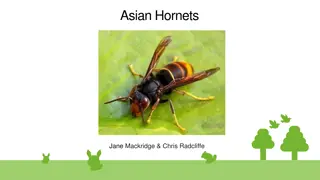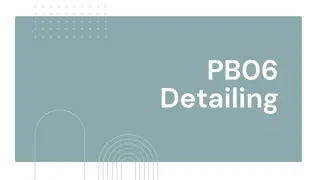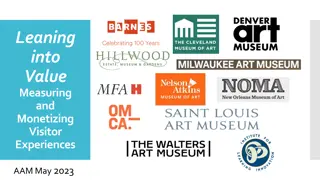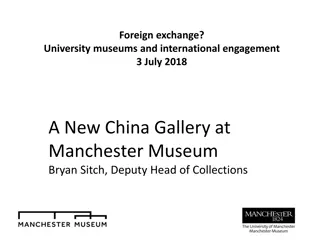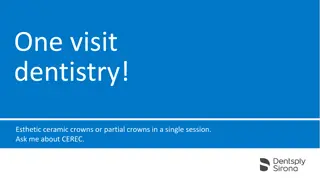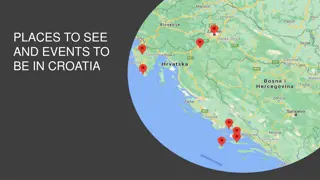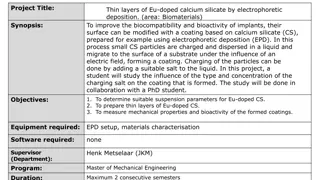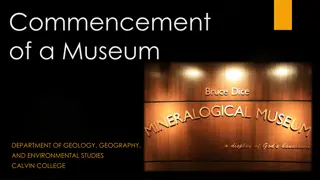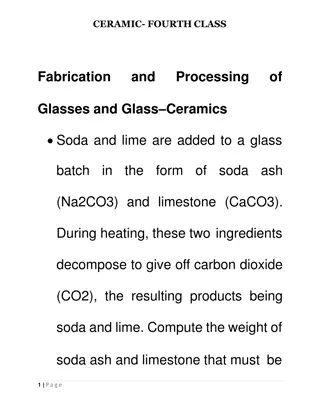Ceramic Characterisation Projects in Collaboration with Museum of Asian Art
Projects involve characterising ceramics from the Museum of Asian Art using techniques like TGA/DTA/TMA, object recognition, and micro-CT. The aim is to classify ceramics based on data obtained from thermal, visual, and microstructural analyses. Additionally, a project focuses on developing a ceramic coating for concrete tiles without high-temperature sintering.
Download Presentation

Please find below an Image/Link to download the presentation.
The content on the website is provided AS IS for your information and personal use only. It may not be sold, licensed, or shared on other websites without obtaining consent from the author.If you encounter any issues during the download, it is possible that the publisher has removed the file from their server.
You are allowed to download the files provided on this website for personal or commercial use, subject to the condition that they are used lawfully. All files are the property of their respective owners.
The content on the website is provided AS IS for your information and personal use only. It may not be sold, licensed, or shared on other websites without obtaining consent from the author.
E N D
Presentation Transcript
Project Title: Characterisation of ceramics using TGA/DTA/TMA In a collaborative program with the Museum of Asian Art (UM) we want to characterise the ceramics in the museum using various methods. One method that has received much attention is thermal characterisation using weight change at high temperature (thermogravimetry, TGA), the enthalpy involved in those changes (differential thermal analysis, DTA) and the change of mechanical properties at high temperature (thermomechanical analysis, TMA). In this project, the student will use these techniques to characterise and classify Southeast Asian ceramics. Synopsis: 1. To obtain TGA/DTA/TMA data 2. To relate the obtain data with the chemical composition and mineral phases present. 3. To classify ceramics based on the results from 1 and 2 using machine learning Objectives: Equipment required: TGA/DTA/TMA Software required: MATLAB/Python/R (choice) Supervisor (Department): Program: Duration: Henk Metselaar (Mechanical) Master of Mechanical Engineering Maximum 2 consecutive semesters
Project Title: Characterisation of ceramics using object recognition In a collaborative program with the Museum of Asian Art (UM) we want to characterise the ceramics in the museum using various methods. In this project, the student should develop a deep learning system, similar to face recognition, that can differentiate Southeast Asian ceramics based on visual images. The images may be obtained from literature as well as from MoAA since we will need many images to train the model. Synopsis: 1. To create an image database 2. To develop a deep learning system that can differentiate Southeast Asian ceramics Objectives: Equipment required: Digital camera Software required: MATLAB/Python/R (choice) Supervisor (Department): Program: Duration: Henk Metselaar (Mechanical) Master of Mechanical Engineering Maximum 2 consecutive semesters
Project Title: Microstructure characterisation of ceramics using micro-CT In a collaborative program with the Museum of Asian Art (UM) we want to characterise the ceramics in the museum using various methods. One possibly non-destructive technique is micro-CT, which gives a 3D density map of the object. The student will have to obtain the CT scans and analyse them in such a way that the results can be incorporated in a machine learning system. For example, grain size, grain size distribution, amount and distribution of glassy phase, porosity would be of interest. The work will be supported by microstructure analysis using FESEM. Synopsis: 1. To obtain CT scans 2. To extract microstructure characteristics from the scan using image analysis/machine learning 3. To classify ceramics based on the extracted microstructural characteristics Objectives: Equipment required: Micro-CT (geology), FESEM Software required: MATLAB Supervisor (Department): Program: Duration: Henk Metselaar (Mechanical) Master of Mechanical Engineering Maximum 2 consecutive semesters
Project Title: Application of ceramic coating on concrete tiles This topic is in collaboration with industry. They are producing roof tiles and would like to have them coated with ceramics. This requires development of a coating technique that does not require sintering at high temperature as that would damage the concrete tiles. Synopsis: 1. To formulate a ceramic coating for use on concrete tiles 2. To characterise the coating Objectives: Equipment required: Ball mill, furnace, hardness tester Software required: - Supervisor (Department): Program: Duration: Henk Metselaar (Mechanical) Master of Mechanical Engineering Maximum 2 consecutive semesters
Preparation of reduced graphene oxide/MgCuZn ferrite composite by hydrothermal method Project Title: Ferrites are interesting materials for microwave shielding in telecommunication devices. In this project, the student will prepare graphene oxide using a modified Hummers method and decorate it with MgCuZn ferrite using hydrothermal synthesis. The prepared powder should be characterised, especially for it s magnetic scattering. Synopsis: 1. To find suitable hydrothermal process conditions 2. To prepare the composite powder 3. To characterise the composite powder Objectives: Equipment required: Oven, FTIR, TGA, vector network analyser Software required: - Supervisor (Department): Program: Duration: Henk Metselaar (Mechanical) Master of Mechanical Engineering Maximum 2 consecutive semesters
